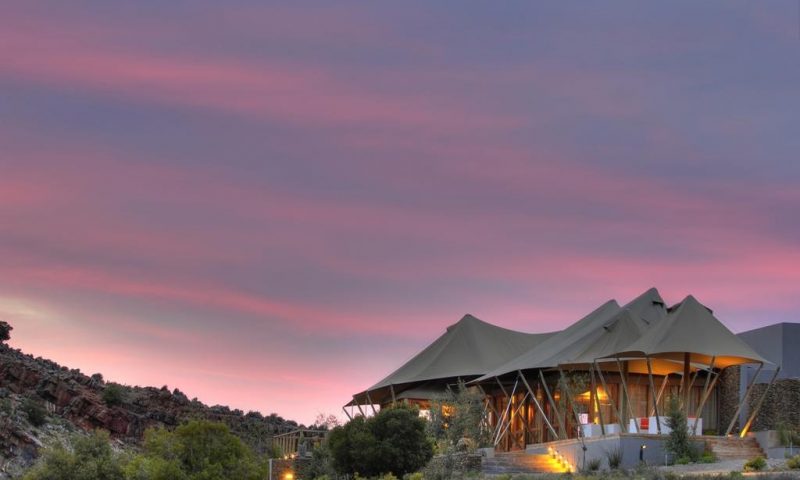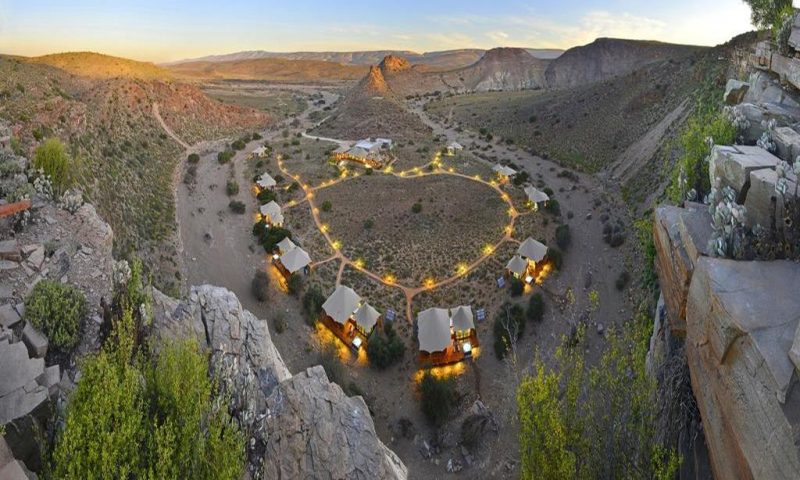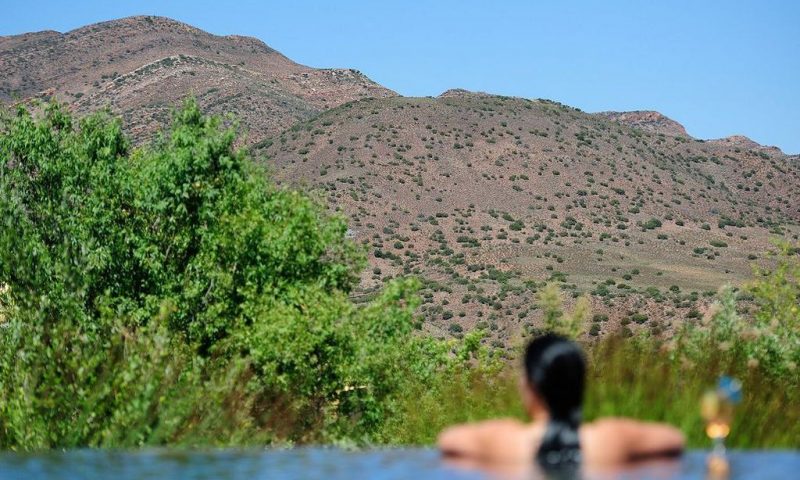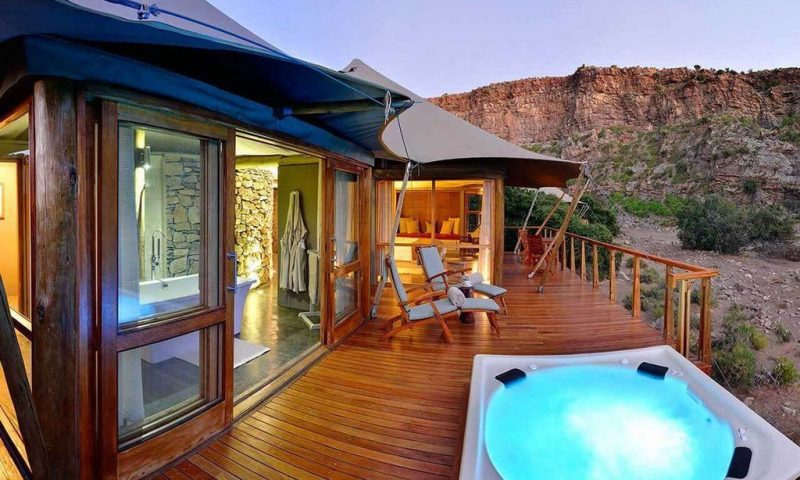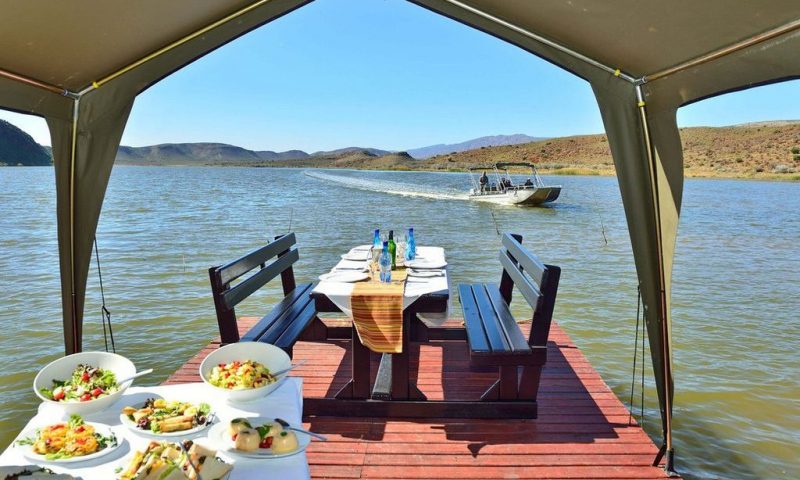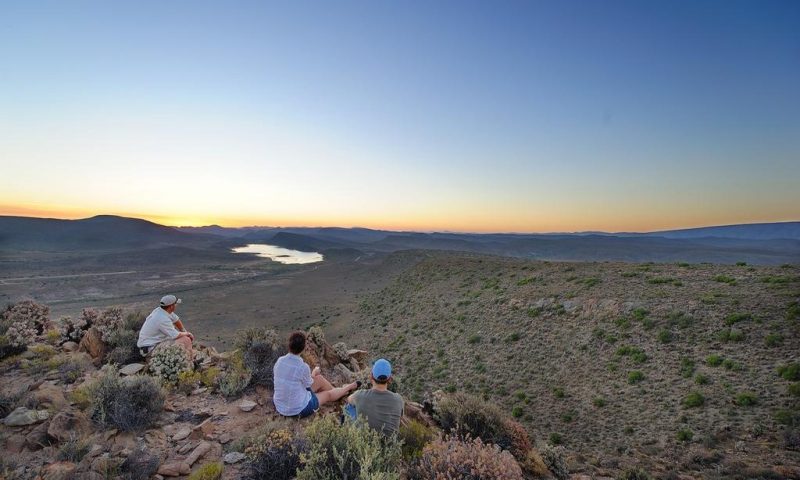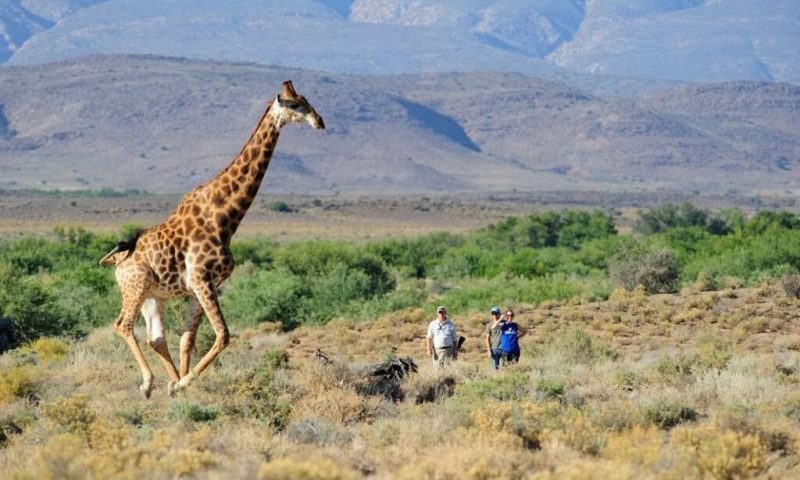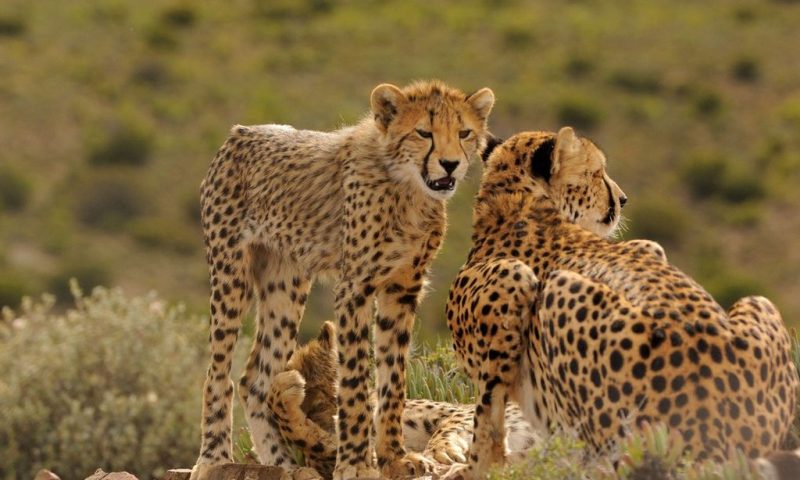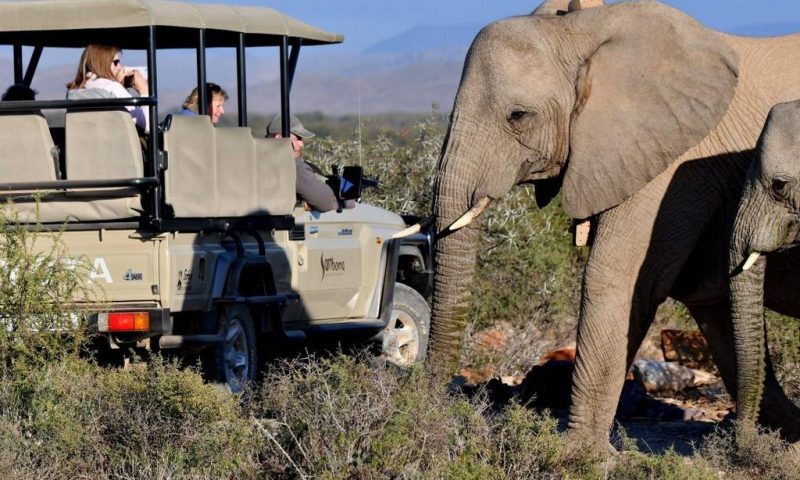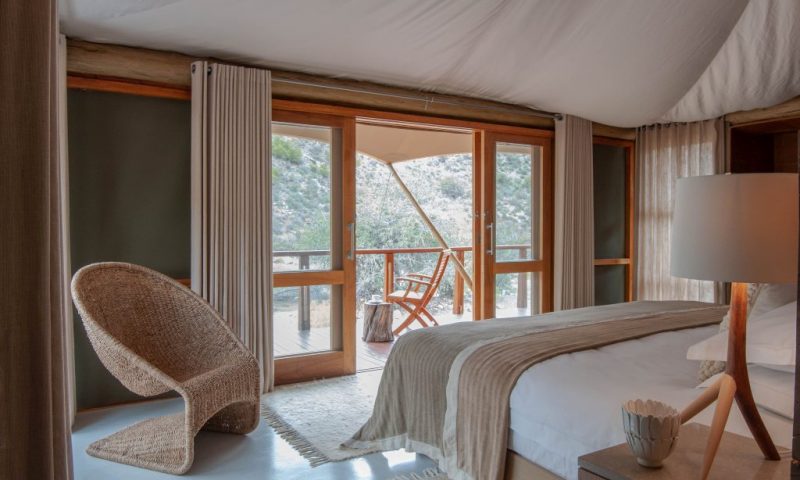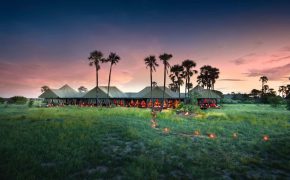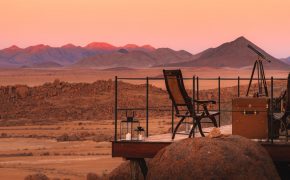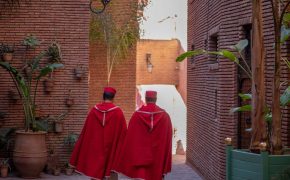At the foot of the towering Warmwaterberg Mountains in the Little Karoo lies the unique safari destination of Sanbona Wildlife Reserve.
Three Luxury Lodges and an adventurous Explorer Camp nestle in 58, 000 hectares of sculpted Cape Fold Mountains and wide-open plains. Take a three-hour scenic drive from Cape Town to the heart of the Little Karoo, along the Route 62, to an unforgettable, malaria-free private game reserve.
Experience a huge diversity of indigenous flora and fauna and rare examples of San rock art, some dating back more than 3, 500 years, plus a unique boat safari and thrilling game drives. Conservation is paramount at Sanbona and every guest contributes to preserving this wilderness for future generations.
More than a Big 5 wilderness reserve, it’s the vastness of the landscape, the alluring stillness and isolation amid raw beauty and boundless plains that make Sanbona unique.
BREEDE RIVER VALLEY
Magnificent views, panoramic landscapes and towering cliffs, streams and the abundance of trees and indigenous flora, all contribute to making the Breede River Valley one of the Western Cape’s most diverse regions.
The ever-changing colours of our majestic mountains, scenic passes, rivers, vineyards and orchards as well as the multitude of attractions, will offer you an unforgettable adventure, whether this is in the physical sense or simply a kaleidoscope of scenic experiences.
Innovation and pride, combined with a terrain and mild climate that are harmoniously balanced, result in the prominence of our region’s wines. The R62 Route which links the Breede River Valley and Klein Karoo, will take you along the longest wine route in the world.
The easily accessible towns, nestled among the Valleys, all offer ample opportunity for discovery. From visits to wineries and game reserves, art and cultural tours, museums, hiking trails and mountain climbing, 4×4 routes and canoeing expeditions, even riding the world’s largest birds, fishing and caves.
You can unwind in one of the invigorating hot-springs, revel in luxury or relax in rustic tranquillity. We look forward to sharing the unexpected pleasures of the Breede River Valley and Route 62 with you!
LUXURY SAFARI ACCOMMODATION
Explore a wilderness sanctuary in the Western Cape while staying at your choice of three luxurious lodges or a back-to-nature Explorer Camp adventure, each of which is surrounded by ancient folded mountains and endless vistas.
Our luxury lodges operate independently, each of which being fully staffed with their own management team, chef brigade, hosts and hostesses and experienced field guides.
Weather permitting, dinner arrangements alternate between the in and outdoor facilities. Each option at Sanbona offers a unique and enriching experience under the African sky. For an exciting experience and adventure, choose the luxury lodge that best suits your travelling needs.
DWYKA TENTED LODGE
Opulent and romantic Dwyka Tented Lodge is embraced by striking rock formations and set in the horseshoe bend of a dry Karoo ravine that is framed by a beautifully weathered landscape.
The spacious lounge and dining areas boast stylish, modern interiors, wooden decks that make the most of the glorious setting and a boma for dining under the stars. The accommodation is luxurious and private.
Each of the nine luxury tents has an en-suite bathroom and a private deck with a Jacuzzi to epitomises the romance of a pioneering wilderness adventure.
For those who enjoy camping, but also appreciate luxury, these tents invoke the feeling of a pioneering adventure. Each luxury tent can sleep a maximum of two adults. There are 9 suites that can be configured as or twin or king bedded luxury tents, each of which have these features:
- Comfort cooling/heating air-conditioners
- En-suite bathroom, shower, twin basins and free-standing bath
- Outdoor shower
- Private deck with spa bath
- Private mini bar
- Tea and coffee making facilities
- International dial telephone
- Electronic safe
When you stay at Dwyka Tented Lodge, you also have access to the other facilities located at Sanbona, which include:
- Open-air dining boma
- Lounge with fireplace and television with satellite channels
- Wine cellar
- Gift boutique
- Relaxation Retreat with 2 therapy rooms
- Wi-Fi
- Additionally, Sanbona Wildlife Reserve offers a host of exciting outdoor adventures and activities which are fit for the whole family to enjoy.
ACTIVITIES AT SANBONA WILDLIFE RESERVE
Along Route 62 in the Little Karoo, Western Cape, lies a piece of heaven known as Sanbona Wildlife Reserve. Located in one of the most diverse regions of South Africa in terms of fauna and flora, your safari holiday is accentuated by the panoramic landscapes and towering cliffs.
Sanbona Wildlife Reserve is packed with opportunities to learn, love and explore nature around you, while residing in luxurious lodges.
For planning and itinerary purposes, Sanbona Wildlife Reserve follows a schedule per season, in order for guests to know when and where our activities are happening. These times are to be used as a guideline and may vary depending on weather conditions.
We do suggest that you arrive in time for lunch on your day of arrival as not to miss out on any game drives during your stay.
April-September (Winter)
- 06h30 Wake up call
- 07h00 Breakfast is served
- 07h30 Depart for morning game drive
- 11h00 Depart lodge
- 13h00 Lunch is served
- 15h00 Depart for afternoon game drive
- 19h30 Dinner is served
October – March (Summer)
- 05h00 Wake up call
- 05h30 Depart for morning game drive
- 09h00 Breakfast is served
- 11h00 Depart lodge
- 13h00 Lunch is served
- 16h00 Depart for afternoon game drive
- 21h00 Dinner is served
GAME DRIVES
Interactive game drives last up to 3 hours and take place in the tranquil moods of sunrise and sunset. Sanbona is an ongoing conservation project that aims to restore the ecological balance in a landscape formed during cataclysmic times 350 million years ago.
Travel through 3 different biomes, and many habitats, including the quartz fields of the succulent Karoo, a very special habitat characterised by beds of angular quartz debris and home to a flora of stunning minute succulent shrubs.
You will traverse this wild landscape with a qualified ranger in a comfortable open Land Cruiser. During the drive, either in the early morning or at sunset, numerous species of plants, animals, big game and birds can be seen.
A hot beverage of your choice is offered during the sunrise game drives. Sundowner evening drives offer spectacular displays of light as the sun sets over the Little Karoo.
Please note – no persons under 4 years of age are permitted to join game drives. To make the best of your safari game drives at Sanbona, do bring along the following:
- Binoculars
- Cameras
- Warm clothing
- Sunscreen
- Hat
BIRD WATCHING
Sanbona Wildlife Reserve is home to more than 200 species of birds, a delight for anyone that’s interested in birdwatching. In fact, the banks of the Bellair Dam alone are home to more than 40 species of birdlife, making it a hotspot of avian activity.
Viewing Delights
Pack your binoculars, notepads, and field guides because there is a healthy population of birds to be seen. And due to the unobtrusiveness of Sanbona Wildlife Reserve, all of them are at ease, which makes for pleasurable viewings and easy sightings.
Whether you’re on a game drive, boat safari, or simply relaxing at one of our luxury lounges, you can expect to see many rare and beautiful birds, such as:
- Cinnamon-breasted Warblers
- Booted Eagles
- Southern Grey Tit
- Namaqua Sandgrouse
- Black-winged Stilts
Birds of a Feather
The Little Karoo is a well-known birding destination. With the contrast of vast plains, mountains, water-courses, and drainage lines throughout the area, it makes nesting for a variety of species easy.
You can expect to catch a glimpse of birds of prey, such as the Jackal Buzzard or Little Brown Jobs like the Chat Flycatcher. You might even find Chestnut-vented Tit Babblers, mingling with doves, mousebirds, and sparrows.
Through our birdwatching activities, you’ll certainly learn about and experience the wonder that is nature. Some species, like the Namaqua Sandgrouse, travel up to 80km in search of water. They collect droplets of water in their breast feathers, and fly back to their nests to deliver it to their chicks.
Best of all, whether you love the larger species like the Ludwigs Bustard, or you’re simply delighted by the more delicate ones like the Black-headed Canary, you and your family are in for a treat.
FLORA & FAUNA
There are over 600 types of flora within Sanbona Wildlife Reserve. Various species bloom at different times throughout the year, but, in this region, flowering occurs more prolifically between August and September.
Sanbona is at the forefront of an on-going conservation project that aims to restore the ecological balance in the area.
Approximately half of the surrounding landscape used to be livestock and agricultural farms, which have since been removed which has allowed the various floral kingdoms that make up the reserve to flourish.
Plant life that inhabits this region of the Western Cape includes Acacia Thickets, Renosterveld, Succulent Karoo and Central Mountain Fynbos. Species of succulents are especially varied and fascinating with names like Baby’s Bottoms, Ostrich Toes and Pig’s Ears.
As part of our conservation efforts, we have reintroduced animals that once roamed the area freely, but were eradicated due to farming. The Big 5 and various other species such as gemsbok, springbok, hartebeest, eland, kudu and zebra can now all be seen on Sanbona Wildlife Reserve.
Other animal species that continue to thrive thanks to the efforts of Sanbona include natural small game such as the:
- Jackal
- Caracal
- Duiker
- Aardwolf
- Aardvark
- Brown hyena
- Grey rhebok
- Steenbok
- Klipspringer
- Grysbok
A riverine rabbit population was discovered on Sanbona in 2006, and as these animals are only known to exist in the central Karoo, they are incredibly rare. Moreover, this species of rabbit is the 13th most endangered mammal in the world.
Sanbona is currently only one of two protected areas that provide riverine rabbit populations with sufficient space and diversity for their ecological processes to function naturally.
KIDS ON SAFARI
At Sanbona Wildlife Reserve, we promote nature conservation across everything we do, from our environmentally friendly Lodges, to the activities we offer you as a guest. Which is why we take great pride in offering children fun experiences at Sanbona that will create future conservationists for the good of our planet.
This spacious thatched Gondwana Family Lodge offers guests a sense of modern comfort with a touch of bush authenticity. Interconnecting rooms, indoor and outdoor play areas and a child-friendly pool cater for guests of all ages. Spending your vacation here ensures entertainment for the whole family.
Upon arrival at Sanbona, kids can expect to have the time of their life through our Kids on Safari packages. With exciting activities planned, interactive welcome packs and even child minding services on request, mom and dad won’t have to worry about a thing.
Outdoor Activities for Children
While kids under 4 years old are not permitted on game drives, there are a host of exciting adventures that await your little ones and mom and dad too, such as:
- Interpretive trail – This takes your kids through the garden of Gondwana, to learn about animals on the reserve as well as their tracks, important plants, and more.
- Sanbona Activity Book – An educational, fun and interactive book, teaching children about the wildlife at Sanbona while also encouraging them to get involved with everyone as they often require the ranger’s assistance to answer some of the questions.
Indoor Activities for Children
- Should the weather not be in our favour, it doesn’t matter because Gondwana Family Lodge is prepared to accommodate the unpredictable Western Cape climate through:
Arts and crafts
- Puzzles of varying sizes and difficulties covering a broad age range
- Documentary DVD’s on various conservation topics and animals as well as animated movies
- Entertaining and educational children’s books
- A selection of fun board games
Special Notes
When travelling with little ones to Sanbona, it’s important to take note that:
- Children younger than 4 years are not permitted on game drives.
- Child minding is done by lodge staff at an additional cost and can be arranged with reservation prior to arrival.
- All swimming activities must be supervised by parents at all times.
WILDERNESS WALKS
Take it all in when you visit Sanbona Wildlife Reserve. We encourage our guests to jump at the opportunity to discover everything the Little Karoo has to offer in terms of fauna, flora and majestic landscapes.
The entire reserve offers an array of nature walks, hiking and wilderness trails for you to explore. Well-informed and experienced rangers can indicate points of interest while divulging important and interesting information about the area.
With the variety of exquisite sites, animals and plants to see while on your excursion, choosing the right time of day is important. Larger and smaller animals alike are most active during the early mornings and early evenings.
During the day you’re likely to catch a glimpse of an array of birdlife nesting, hunting or travelling through the area, with waterholes being the most prominent area. Each adventure is appropriate for any fitness level, from easy walking tours to more advanced hiking trails.
EVENTS & WEDDINGS
Sanbona is a place to relax and feel inspired, a magnificent reserve of 58,000 hectares where big cats roam free. Get away from it all and give your team the chance to focus on business strategy and development without being interrupted, in a truly relaxed and inspiring environment.
An entire team-building experience can be tailored to suit your individual requirements, from star gazing, understanding conservation and retracing the steps of the San people, to tracking cheetah and getting a glimpse of the white lions that call Sanbona their home.
Activities could include: (Subject to availability, conditions apply)
- Morning and evening game drives – including a chance to see our famous white lions
- Bird watching – with more than 200 species, including Raptors, the beautiful Fish Eagle and five breeding pairs of Black Eagles
- Astronomy – learn about the stars that are so clearly visible here
- Archaeology – visit local archaeological sites and take part in guided ‘rock art’ walks
- Bush survival skills training – tailor-made activities to suit your team-building requirements
- Conservation and wildlife talks
- Botanical guides – to explain everything you need to know
- On-site spa
WEDDINGS & HONEYMOONS
There is no more romantic place for a Bush Wedding than at Sanbona Wildlife Reserve – tailor made to your requirements. We will assist you will all aspects of your dream wilderness wedding from the ceremony to the celebrations to the honeymoon.
PHOTOGRAPHY
Nestled just outside of the spectacular town of Montagu, Sanbona Wildlife Reserve offers exquisite landscapes, majestic rock formations and an abundance of animals, birdlife, flora and fauna to appease an array of tastes. Thus making this slice of the Western Cape region a photographer’s dream.
These natural endowments coupled with near perfect light conditions, enable photographers of all expertise the chance to capture wildlife scenes that surpass their expectations.
Whether you prefer photos of game and panoramic landscape shots or want to capture close-up details of the smaller species of insects and plant life on the reserve, your choices are endless.
So, when you’re on your game drive, nature walk, or water safari, be sure to bring your camera so that you don’t miss any magnificent photo opportunities.
RELAXATION RETREATS
Awaken your senses and rejuvenate your body, mind, and soul with one of the relaxation retreat therapies exclusive to Sanbona Wildlife Reserve. Inspired by surrounding nature and the four elements, our selection of body and beauty treatments cater for both men and women.
Indulge in Serenity
Step into the privacy, luxury, and comfort of our tranquil retreats and let the gentle atmosphere envelop and embrace you.
All of the Relaxation Retreats at our safari lodges are situated within the natural landscapes of Sanbona Wildlife Reserve. While the rejuvenating forces of nature cradle you, we deliver a range of world-class treatments and holistic modalities to balance and energise your being.
Our spa safari relaxation retreat lodges each boast two therapy rooms and are available at all of our lodges:
- Dwyka Tented Lodge
- Gondwana Family Lodge – also equipped with a steam room.
- Tilney Manor – also equipped with a steam room and sauna
Treat yourself
Each lodge offers our signature treatments for tension, stress release, cleansing, relaxation, as well as rejuvenating facial treatments. A choice of massage, beauty, manicure, and pedicure treatments are also available.
When you choose to have a spa treatment, it’s important that you read through and understand our “Relaxation Retreat Etiquette”, which is as follows:
- Arrive five minutes prior to your treatment time
- Please be silent and respect other guests’ treatment time
- Strictly no nudity
- Please inform your therapist if you have any health problems prior to your treatment
- Price list is subject to change without prior notice
- Please switch off all mobile phones
- Should you wish to cancel your appointment, kindly note that three hours notice is required or the full amount will be charged.
ROCK ART
Aside from the array of game and majestic landscapes, another of the exquisite attractions available at Sanbona Wildlife Reserve is the ancient rock art found here.
There are seven recorded sites throughout Sanbona. These rock art sites date back more than 3,500 years and depict the spiritual beliefs and lives of the San and the Khoi-Khoi people that lived in this area until 100 years ago.
Following History
The San were nomadic hunter-gatherers and the Khoi–Khoi were pastoral herders who owned livestock such as cattle and sheep. The rock art is a product of what the Shaman of both Khoi-Khoi and San people envisioned in their trances.
But, the paintings are very different from each other. The San paintings are more representative of animals, people, and beings and are done in a darker red colour due to the ochre they used.
Whereas the Khoi-Khoi paintings are more ‘orangey’ and symbolic in style. The paint was made from ochre, calcrete, animal blood, animal fat, plant sap, and ostrich eggs, which they ground to a paste.
Historic Rituals
During their travels, members of these groups would congregate around a communal fire, weaving stories and celebrating the gift of life while the Shaman would meditate in a trance through rhythmic dancing, singing, and clapping, receiving visions as guidance.
This would ensure the wellbeing of the tribe, protecting them from evil and sickness, predicting the future, and praying for good hunting and rains.
It’s also during these rituals that certain animals such as the praying mantis and the eland were honoured and revered as they were considered to have great spiritual powers.
These trance experiences of the Shaman were depicted to the tribe in the form of the rock art seen today. The various sites were also very symbolic, as the rock face was seen as a portal between the different realms the Shaman had travelled through in his trance.
Preserving the Past
Some of the only evidence that remains of this way of life is depicted through this delicate rock art. This makes Sanbona Wildlife Reserve, not only a leading destination for an African experience, but a national treasure in terms of heritage.
BOAT SAFARIS
Let yourself and your family or travelling companions experience Sanbona Wildlife Reserve from a different angle.
With the vast and impressive Bellair Dam situated on the property, guests can enjoy our boat safari activities, from the comfort of our spectacular vessel, The Peregrine. This tour is subject to water levels in the Bellair Dam as Sanbona is situated in a water-scarce area.
Waterways Tour
Named after a bird of prey, the Peregrine Falcon, this boat embarks on water safaris that takes you into, what was once, uncharted territory.
Through these guided tours, 12 guests are seated comfortably as the boat takes you on either a sunrise or sunset cruise, weather permitting. These are the best times of the day to enjoy a safari,as this is when the animals are at their most active.
Additionally, guests can gain a new perspective of the reserve and potentially see:
- The Big 5
- Hippos
- A variety of birdlife.
Best of all, if you’re travelling in a larger party for work or leisure, you can book a Peregrine boat safari exclusively, at an additional cost. The Peregrine is able to navigate through even shallow waters and offers access to most areas of the dam.
Built almost 100 years ago, this dam is considered a bird watching haven as more than 40 species of birdlife flock here to nest, feed, and drink. Guests get a chance to see the newly built dam wall, and on a hot summer’s day, swim whilst enjoying vistas that are only found in the Karoo.
Additionally, our knowledgeable guides not only point out rare species of birds and identify calls, but they also share interesting and important information about the dam and the Reserve itself.
STARGAZING
One of the great wonders to experience at Sanbona Wildlife Reserve is the night sky. Free from light and city pollution, the Klein Karoo offers some of the finest stargazing in Southern Africa and is an ideal activity for all guests to enjoy.
Each lodge has a high-powered telescope and dedicated ranger who utilising a laser pointer guides you through the awe-inspiring constellations and planets.
Seasonal Sights
As part of the constellations on show, in summer, Orion can be seen alongside Taurus the bull, and the Seven Sisters. But, as winter comes around, Scorpius, with the red giant star Antares at its’ heart and the distinctive Southern Cross, come into view.
Experienced or professional astronomers can sit back and enjoy the neighbouring dwarf galaxies, also known as the large and small Magellanic Clouds.
Other deep space features that can be viewed with the telescopes provided at each lodge include the Orion and Carina Nebulas, and not forgetting Tuc47, another brilliant star cluster.
A Night Under the Stars
Stargazing can be conducted at the lodges but can also be incorporated on night drives. Although the winter months may be colder, they offer even better viewing as heat and dust are greatly reduced in the atmosphere, offering a clearer view of the sky.
It’s the ideal activity for the whole family. Guides are happy to explain to younger guests the unique aspects of the Karoo sky, which is not only educational for them, but mom and dad might learn a thing or two as well.
CONSERVING SANBONA
As custodians of 58 000 hectares of vastly diverse and sensitive landscape within the Little Karoo, responsibility is bestowed upon us to preserve and develop sustainably. Conservation management is the foundation on which Sanbona was established, and will always be a priority.
Sanbona has been a pioneer of conservation, reserve development and eco-tourism of this scope within the Western Cape. Our dedicated Wildlife Department consists of:
- Wildlife veterinarians
- Ecologists
- Conservation managers
- Security operatives
- Field staff
Together, we manage our unique ecosystem and ensure that we achieve our objectives, while preserving and refining the ecological, commercial, and social integrity of the area.
FLORA
The vegetation of Sanbona consists of three biomes; Fynbos, Succulent Karoo and Thicket, of which the first two are globally recognised ‘biodiversity hotspots’, defined as ‘regions that contain at least 1 500 species of vascular plants (> 0.5% of the world’s total) as endemics, and must have lost at least 70% of their original habitat.’
Vegetation is the natural result of a myriad of environmental parameters that can be most easily explained by the interplay between geological formations and rainfall.
The Warmwaterberg Mountain Range comprises the oldest geological formation on Sanbona and is part of the Table Mountain Group, a sedimentary rock that develops into acidic, nutrient poor soils.
The Fynbos biome thrives on these acidic soils on the Warmwaterberg. The geology on the rest of the Reserve comprises mudstones and siltstones of the Bokkeveld and Witteberg Formations that form nutrient rich, clay soils derived from shales.
The Warmwaterberg bisects the Reserve and creates a rain shadow on Sanbona. The nutrient rich soil in the south of the Reserve which receives a higher rainfall supports the critically endangered Renosterveld vegetation of the Fynbos biome.
North of the Warmwaterberg the average rainfall drops dramatically and the vegetation shifts to the more arid vegetation of the Succulent Karoo biome. Arid Mosaic Thicket of the Thicket biome occurs throughout the Reserve, and is the driest of all the Thicket vegetation types.
250 years of agricultural impact on the Little Karoo has also left its mark and influences the conservation management objectives of today, and will for many years to come.
Fences, road networks, overgrazing, trampling and ploughing all leave scars on the landscape and the Wildlife Department must attempt to facilitate natural rehabilitation of the vegetation.
This is achieved by combating soil erosion, halting the spread of alien invasive vegetation and managing the impact on vegetation by game. In a semi-arid environment such as Sanbona, this process cannot be achieved quickly, although we are establishing the fundamentals.
FAUNA
A priority for the Reserve has always been the re-introduction of species that once naturally roamed through the Little Karoo.
Although historical records are used, re-introducing species to their natural range must take into consideration the suitability and extent of the available habitat and the presence of potential competitors.
Due to the change in vegetation type, some areas may no longer be suitable for the habitat requirements of certain species. The process of returning the large herbivore and predator species has taken many years and is still ongoing.
The Wildlife Department researches the ecology of the animals within their new environments to ensure success and sustainability of the processes.
The impact of predators on their prey as well as herbivores on vegetation must be studied, measured and monitored continuously to establish the correct ecological balance that will ensure a productive, self-sustaining ecosystem on Sanbona for years to come.
ENDANGERED SPECIES
A number of flora and fauna species that occur on Sanbona are of Conservation Concern, as described in the IUCN (International Union for the Conservation of Nature) Red List of Threatened Species. One important species demanding attention is the Riverine Rabbit.
Sanbona is one of two protected areas with a population of riverine rabbits that provides sufficient space and diversity for ecological processes to function naturally. Sanbona has become a major role player in the conservation of this species in the Little Karoo.
The highly elusive Riverine Rabbit is the 13th most endangered mammal in the world. The Wildlife department continually monitors the population and shares information gained with CapeNature and the Endangered Wildlife Trust.
The presence of a healthy Riverine Rabbit population on the Reserve is confirmation of the vital role played by the private sector in biodiversity conservation.
RESEARCH AND MONITORING
Over 55 percent of the Little Karoo is moderately degraded and only 18 percent in a pristine condition.
Lower soil nutrients and loss of palatable plant species are results of this degradation and the challenge is developing the correct balance between improving soil and plant quality, herbivore densities and predator populations in order to facilitate the rehabilitation of the ecosystem.
The Wildlife Department is continuously and actively involved in various internal monitoring and research projects, and also facilitates external research associated with and conducted by various institutions.
SECURITY
We strive to not only care for our environment of great species diversity and richness, but also to ensure the safety and security of our guests and staff. Our anti-poaching and security unit of well-trained personnel continuously patrol and monitor; and strive to ensure our protection.
WILDERNESS AREA
Due to the topography of the landscape, roughly 5000 hectares of the mountainous western area of the Reserve are virtually inaccessible and stochastic management approaches are adhered to, ensuring a Wilderness philosophy. These unspoilt areas can only be explored on foot.
STEWARDSHIP
Due to its commitment to conservation, Sanbona is managed by its own strict ecological principles which are supported by CapeNature. Sanbona has entered into a Stewardship Programme with CapeNature. As a result of this agreement we will receive perpetual Protected Area status.
“Within the context of conservation, stewardship means wisely using natural resources that you have been entrusted with on your property, protecting important ecosystems, effectively managing alien invasive species and fires, and grazing or harvesting without damaging the veld.”
SUSTAINABILITY
The ethos behind the management philosophy of Sanbona Wildlife Reserve is to ensure that the Reserve is sustainable in the long term on three fronts: Financial, Ecological and Social.
We are granted an opportunity to conserve and protect this land on ground level, maintaining the ecological integrity of this diverse and sensitive landscape for generations to come.
SUSTAINABLY SANBONA
Conservation efforts within Sanbona are linked across all aspects of the Reserve. Sustainability and responsible utilisation are foundations for our day to day management at our lodges, administrative buildings, staff villages and workshops.
To assist our endeavours to be as effective as possible, we at Sanbona have partnered with the world renowned and respected Wilderness Foundation and their Green Leaf Environmental Standard (GLES) programme.
This programme was born out of a need to ensure that within the African Tourism Industry, a process was put in place which focused on environmental best practice, with the end goal being the achievement of sustainable tourism.
Having researched global environmental and sustainable measurement standards, the GLES designed a structure that would enable tourism properties to be graded on, thereby making them aware of a broad spectrum of criteria.
Sanbona constantly strives to comply with and improve on the Green Leaf measures. Throughout all aspects and departments of Sanbona, processes and infrastructure are in place to help us run as ecologically sound a tourism experience as possible.
The main considerations are; effective water and energy usage, including the capture of rainwater and the use of wood from alien plant species for fire places.
Waste management includes the recycling of raw materials, composting of food waste and the filtration and use of grey water for irrigating lodge gardens. A final but equally important aspect is the education and upliftment of local communities and staff.
The aim of Sanbona, using the GLES, is to reduce the effects of consumption on our environment and improve upon environmental management and awareness in an eco-friendly manner, by addressing the direct impact of the Reserve on the environment, reducing our carbon footprint and improving the environmental education of owners and consumers alike, towards realising ways of enjoying the tourism product without compromising quality and experience.
HISTORY OF SANBONA WILDLIFE RESERVE
In 1998 Linton Projects (Pty) Ltd. conceptualised the establishment of a private nature reserve, 27 000 hectares in extent, named the Cape Wildlife Reserve.
This reserve was concentrated in the south and west area of the Warmwaterberg and was envisaged to operate a resort complex within a private nature reserve. 39 individually owned lodges along the banks of the Kalkoenshoek River were proposed, and permission was granted for the development in January 2000.
This endeavour, however, was not financially successful. And in 2002 the reserve was acquired by a private company. It was extended to the north and east, incorporating land adjoining the Warmwaterberg Forest Reserve and towards the Anysberg Nature Reserve.
Altogether, 19 agricultural farms, previously utilised for wheat and lucerne crops, domestic animal production (cattle, sheep and goats), game farming, recreational farming, and tourism were bought. The reserve size was increased to over 58 000 hectares, forming what is today, Sanbona Wildlife Reserve.
The focus was shifted from private lodge development to the creation of exclusive five star accommodation for nature based tourism.
Tilney Manor was opened in 2002. Tilney is an original farmhouse dating back to 1898 and is named after Thomas Tilney. He was born on 15th July 1816 in North Shields (then called Northumberland) England.
A successful marine captain, harbour master and, finally, a magistrate in the Cape Civil Service, he eventually became the Resident Magistrate of Swellendam, and passed away in 1899. Today, Tilney Manor bears his family name and still falls within the jurisdiction of Swellendam Municipality.
In 2009 two new lodges, Gondwana Family Lodge and Dwyka Tented Lodge, were completed, adding to the historical Tilney Manor.
Dwyka is set in a magnificent horseshoe bend of a dry riverbed with a breathtaking view of the cliffs that protect it, while Gondwana family lodge is a modern thatched two-story lodge with awe-inspiring views of the Bellair Dam and the distant picturesque Anysberg Mountains.
In 2011 ownership was assumed by Dubai World Africa and the reserve was restructured under the Shamwari Group.
In 2012, a seasonal Explorer Camp was initiated, a two day walking safari with luxurious tents as accommodation, giving a sense of how the original safaris were enjoyed. The location changes each summer in order for repeat guests to truly get a sense of this unique Karoo wilderness area.
In 2015 Sanbona was purchased by the Caleo Foundation, a non-profit, conservation organisation – the birth of a new beginning for Sanbona Wildlife Reserve then began. Existing conservation projects will continue and be enhanced to ensure the vital protection of this pristine Karoo wilderness area.
